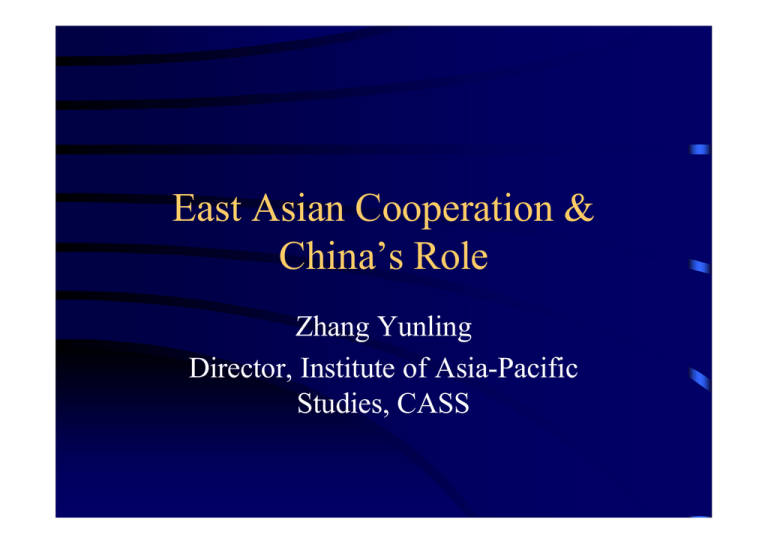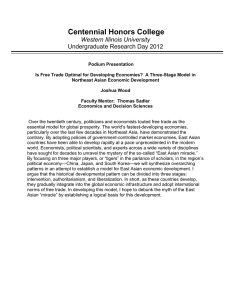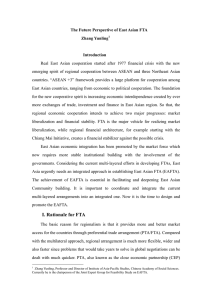East Asian Cooperation & China’s Role Zhang Yunling Director, Institute of Asia-Pacific
advertisement

East Asian Cooperation & China’s Role Zhang Yunling Director, Institute of Asia-Pacific Studies, CASS I. Progress of East Asian Cooperation ♣ East Asian cooperation is under the framework of “10 plus 3”, started from November of 1997 by leaders meeting. ♣ Progress has been made in the areas including institutional framework, financial and monetary cooperation, sub-regional project, as well as long-term vision. Institutional Framework Æ Leaders’ annual meeting Æ Ministers’ meeting(foreign ministers, trade ministers, financial ministers) Æ Functional cooperation programs Æ Forums Financial Cooperation • Financial and monetary cooperation represented by Chiang Mai Initiative(CMI) and regional financial surveillance has been turned into reality. • CMI sets up a foundation for future regional financial regime, like a regional monetary fund. FTA • ASEAN announced the completion of AFTA • China-ASEAN agreed to establish a FTA within 10 years, formal negotiation will start this year. • Some bilateral free trade arrangements were concluded and more ahead. • East Asian FTA was recommended. Other Areas • Great MeKong River Development Project was initiated by ADB, but not has been taken into the framework of East Asian Cooperation. • Cooperation in other areas, like human resource, capacity building, infrastructure, science & technology has achieved progress. Driving Force • The increasingly binding economic interests encourage countries in the region to cooperate. • In face of globalization, it is necessary for East Asia to strengthen dialogue and cooperation to meet the new challenges. Driving Force • The Asian financial crisis posed an urgent need for East Asian countries to strengthen cooperation. • There is the clear political understanding in promoting regional cooperation: stability, peace and prosperity through cooperation. II. Where to Go? • East Asia cooperation moves in a “four wheels” process: “10 plus 3”, “10 plus 1”, “3” and “10”. Multi layered process represents the reality of East Asia. • East Asian cooperation is not exclusive. It allows and encourages other parallel arrangements with other regions. Vision Vs. Process • • • • EAVG recommended in 2001 to leaders: Turn “10 plus 3” into East Asian Summit East Asian FTA Comprehensive cooperation including political, social,cultural, as well as security areas. • Toward a community Vision Vs. Process • The real value of East Asian cooperation is its process. It has to follow gradualism and pragmatism. • East Asia is different from Europe. It lacks a clear defined political goal and consensus building. • Institutional building works in its gradual process. Optimism • China-ASEAN FTA process will press the other countries, especially Japan and Korea to join the process. • The SWAP arrangement may lead to a regional monetary fund. • More regional institutions will be established and finally move to a regional organization. III. China’s Role • China is very active in promoting and participating East Asian cooperation. • Due to its increasing economic weight and power, China’s role in the regional economies becomes larger. • After joining WTO, China becomes more confident and interested to formulate free trade arrangement with other partners. China-ASEAN FTA • China-ASEAN FTA will create a large economic region with population of 1.7 billion, GDP $ 2 trillion and trade$ 1.23 trillion now. Intra-regional trade and investment will increase. • Attract more FDI with a more rational allocation, i.e.no longer a ”zero sum” choice between China and ASEAN. China’s Increasing Role • By keeping high economic growth rate and stable currency, China has made positive contribution to the regional economies. • China contributes growing market for the other economies. • China’s FDI in the region will increase very potentially in the coming years. Export to China as % of GDP(Group I) 30 25 HK 20 Taiwan 15 Singapore 10 Korea 5 Mongolia 0 China Japan USA Export to China as % of GDP(Group II) 25 Malaysia 20 Thailand 15 Indonesia 10 Philippines 5 Vietnam 0 China Japan USA 20 10 Korea Philippines 30 East Asia Taiwan Singapore 0 Thailand 40 Malaysia 50 Indonesia Export Share to Japan 1990 2000 Export Share to China 8 East Asia Singapore Philippines Thailand 0 Malaysia 2 Indonesia 4 Taiwan 10 1990 2000 6 Korea 12 China’s Potential nDue to its economic size and import capability, China’s role to the regional economies still limited, not an engine for East Asia yet. nThe potential of China’s market is considerable: high economic growth may sustain for another 10-15 years at the rate of about 7%. nImports doubled within 5 years, to $500 billion, 60% from East Asia.






